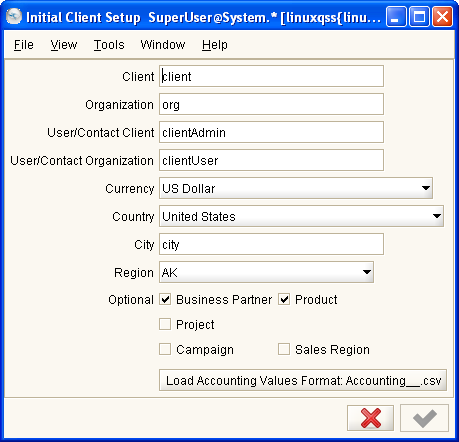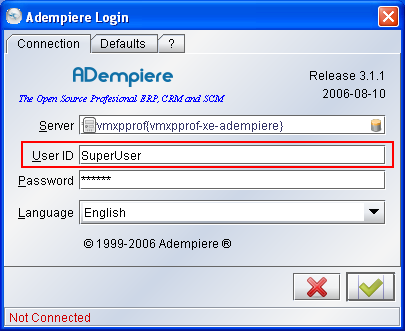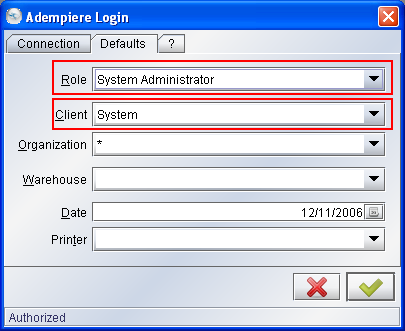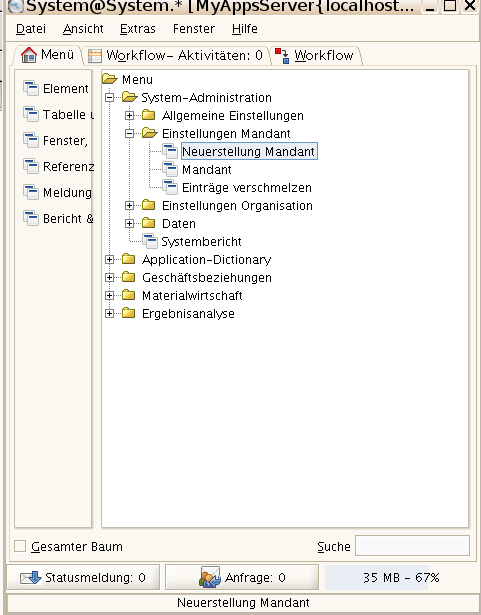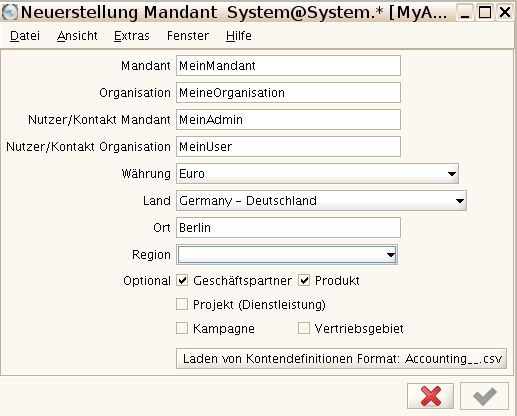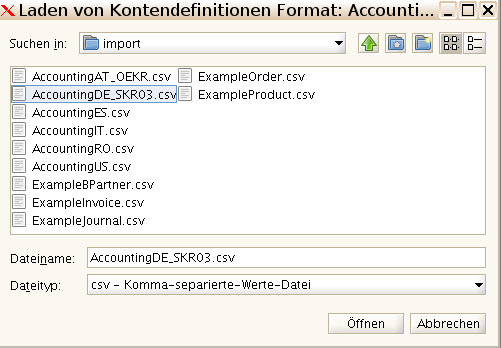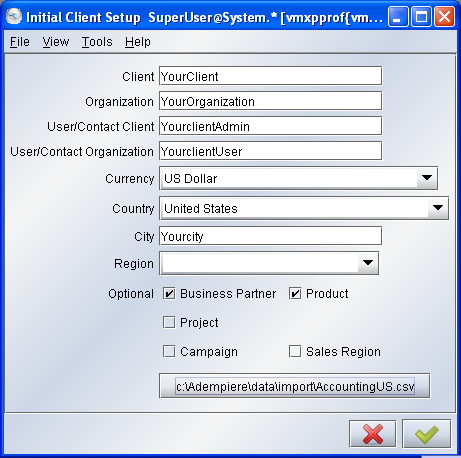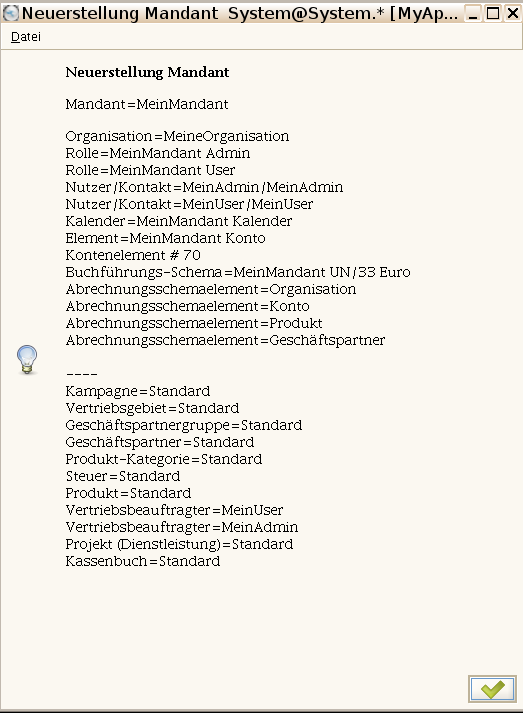De DE/Mandant erstellen
Enjoy it, and help to fill it! But please, always respecting copyright.
Please write your contributions under the Contributions Section
Contents
Form: Initial Client Setup
Description : Initial new Client/Tenant Setup
Help : Set up a new Client/Tenant of the system
Class Name: org.compiere.apps.form.VSetup
Contributions
Summary
Before you can start using ADempiere for your business, you have to define a new Client, Organization, Users, etc. These become the initial parameters in your system.
Introduction
- The Client is the highest level of an independent business entity. Each Client will have one or more
- Organizations reporting to it. Each Client defines the
- accounting parameters (Accounting Schema,
- Tree definition,
- Non Monetary UOM's).
ADempiere has already two clients predefined for you. The first is the
- System Client, which you will use to add your Client and configure your system.
- GardenAdmin is a sample Client, you can use for testing purposes, and have some datas inserted
- (as Business Partners,
- Products,
- Banks accounts, etc.).
You do not delete these two clients, but create a new one for your business
Beginn der Implementierung
- Login Sie sich in ADempiere mit dem Benutzer System oder SuperUser ein,
System Administrator Rolle und System als Client/Mandant
- Gehe zum Neuerstellung Mandant Fenster:
- und öffne es:
- fülle dann die Felder mit deinen Daten.
Manche Felder:
- Mandant: der Name deiner Firma.
- Organisation: häufig ist eine juristische Person oder eine Untereinheit, für die Dokumente und Verhandlungen verarbeitet werden. Durch Beispiel füllten wir mit MeineOrganization; Sie können andere definieren Organisation in einer neueren Zeit. Häufig in den Kleinunternehmen sind der Klient und die Organisation die selben.
- User Client und User Organization sind die ersten Benutzer mit denen Sie sich einloggen können.
- Lassen Sie die Business Partner und die Product checkboxen markiert und
- die anderen unmarkiert. Diese Auswahl wird verwendet um das Kontierungsschema zu definieren. Nachher, wenn man möchte, kann man diese Einstellungen verändern, z.b. um Verkaufsregionen, Projekte usw. hinzuzufügen.
Bitte beachten Sie, der OK Button ist deaktiviert. Bevor Sie weitermachen können müssen Sie folgende Punkte erledigt haben
- wählen Sie den Laden von Kontendefinitionen Format button.
- wählen Sie die Datei AccoutingDE_SKR03.csv,
Sie können auch ihre eigene Accounting Datei erstellen, basierend auf diesem Beispiel und laden dies anstelle.
- Dann drücken Sie den Load Accounting button...
- und wählen ihre Kontendatei.
Nun, wie Sie sehen können ist der OK Button nun aktiv, und der Pfad zu ihrer Kontendatei wird angezeigt. Drücken Sie OK um fortzufahren...
- warten Sie auf den Prozess bis er fertig ist
Dann öffnet sich ein neues Fenster:
welches die Benutzer, Rollen und alle Standardeinträge welche erstellt wurden.
Refining the implementation
The next step will be to check and update the initial settings. To do it,
- logout from ADempiere,
- and login again,
but with your client-level Role you have just created (YourclientAdmin in the example).
Then we'll go to the Initial Client Setup Review workflow to continue.
Tips
- In order to assure the standard default entities were created and the security infrastructure was defined correctly, the only way to add new clients is through the Initial Client Setup form.
- The Initial Client Setup will load only the defaults accounts. In order to load all your non default accounts and create your account hierarchy, you must log in the system with your new Admin Role. Now there are two steps to follow. First go down the Menu to System Admin > Data > Data Import > Import File Loader and choose your COA file (set the Import Format to 'Accounting - Accounts' value). Confirm your choice and the accounts already reside in an I_* table in the database. The second step in the import procedure (by placing the imported accounts into a PA_* table in the database) is to go down the Menu to System Admin > Data > Data Import > Import Account window. In there just press the 'Import Accounts' button. Choose your relevant Element and data-importing behavior and confirm. After the process is finished you have to log out and log back in. If you select the 'Element Value' tab in the Account Element you will see your Chart Of Accounts organized in your preferred hierarchy. By the way this two-staged importing mechanism is employed in the addition of the major business objects into your system (e.g. Business Partners, Products, etc.).
- About Accounts File: If you change the .csv example file, to adapt to your needs, be careful: you must have only and only one account defined for each of the Default Accounts. Otherwise, the process will fail. The file is required with unmodified structure when you initially create a new Client. To change the example account file, we advice you:
- Delete all lines with exception of the ones, which have Default Accounts.
- Change the lines (value/key, name, description) as you need for your chart of accounts.
- Add the other accounts in your chart of accounts.
- Above steps are easily done using Adempiere Account editor
Links Checklist
- InstallServer DONE
- InstallClient DONE
- Installing ADempiere DONE
- Tutorials on many things from basic to advanced.
